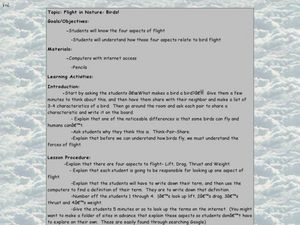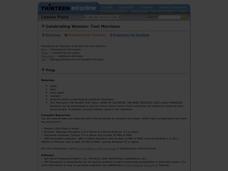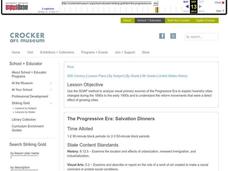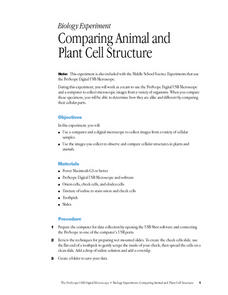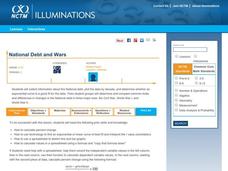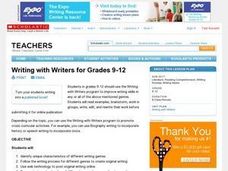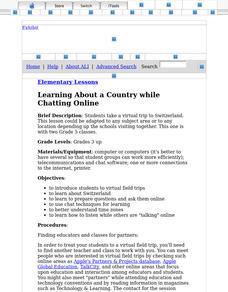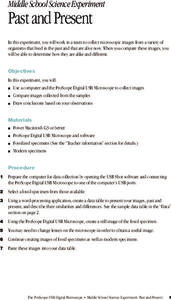Curated OER
Flight in Nature: Birds!
Students discover how flight works by researching birds. In this animal life lesson, students utilize the Internet to find information about the four aspects of flight. Students define the four aspects and label a worksheet...
Curated OER
Lesson 5: Designing an Experiment
The intent of this lesson is to introduce young scientists to the steps of the scientific method. To this end, they consider the question, "Which brand of battery lasts longest?" In this case, the experiment is carried out as a class,...
Curated OER
Collected Works
Students consider why people collect stamps and other items and how the Internet has changed hobbies. They review stamp collecting Web sites and brainstorm how the Web can serve another popular collectible.
Curated OER
Noncombatancy and the Seventh day Adventist Church
Upper graders investigate how the Seventh Day Adventists are objectors to the practice of war. The lesson covers the Civil War and examines the church's position about the practice of war. The research extends to modern wars and learners...
Curated OER
Nuts and bolts
Students work in groups to create a storyboard about their video. They shoot a video designed to teach others to connect the computer and camcorder and how to capture video in Adobe Premiere Elements editing program.
Curated OER
Digital Video Photographers
Young photographers explore the world of digital videography. Learners take videos with a digital camera, upload them to a computer, then utilize iMovie software to put together a presentation. This should be an exciting learning...
Curated OER
Celebrating Women: Toni Morrison
How authors address issues of their societies is addressed in this very detailed lesson. After researching Toni Morrison and her work, groups create a dramatization based on a scene from one of Morrison’s novels and act it out. Class...
Curated OER
The Progressive Era
Eighth graders utilize the SOAP method to analyze a work of art and relate it to what they know about the Progressive Era and the reasons why cities changed and the ways in which cities changed during the end of the 19th century. They...
Curated OER
Comparing Animal and Plant Cell Structure
Young scholars work as a team to use the ProScope Digital USB Microscope and a computer to collect microscopic images from a variety of organisms. When they compare these specimens, they are able to determine how they are alike and...
National Nanotechnology Infrastructure Network
Small Scale Sculpting: Etch Lab
Make works of art using a vintage yet effective etching strategy. The surface of a semiconductor chip has specific patterns formed through a process called etching. Through a lab investigation, young scholars recreate that process...
Curated OER
Power to the Pedal!
In this pedal power worksheet, students solve a math puzzle in order to determine how much power could be generated by pedaling a bicycle. They try to figure out how much power would be needed to run a child's laptop, and how much...
BBC
Global Community: T-Shirt Activity
Examine fair trade and the impacts it has on the global community. Kids consider how t-shirts are made, where they come from, and how fair trade works. They design t-shirts that describe the affects of fair trade on various populations...
Curated OER
Planet Impact!
An amazing information-packed lesson plan allows your space scientists to crash a virtual comet into Jupiter and learn how the angle, distance, speed, and mass influence the outcome. Click on "Back to the Lesson" to access the...
Curated OER
Alphabet Poems
Develop fluency with a variety of works. Help kindergartners use multiple strategies to understand text and decoding. They will create an alphabet poem book on Kid Works 2 to illustrate and write their own poem. In the end, they will...
National Council of Teachers of Mathematics
National Debt and Wars
Take a functional approach to the national debt. Learners collect information about the national debt by decade and plot the data. They determine whether an exponential curve is a good fit for the data by comparing the percent changes...
Curated OER
Writing with Writers for Grades 9-12
Have your class examine the characteristics of various writing genres using the Writing with Writers online project. Detailed instructions for how to introduce, discuss, and develop a piece of writing for each genre are included. Class...
Scholastic
Holes Match 'Em Up Challenge
Upper graders read the book Holes as a class or by themselves. In groups, they identify symbols and discuss how they are connected among the many plots in the story. They create a timeline in which they sequence the main...
Curated OER
Slope-Intercept Form of a Line
Using the subscriber website Explorelearning.com, young mathematicians observe changes in the slope and y-intercept and their effect on the graph of lines. This activity helps students develop an intuitive sense of the connection between...
Curated OER
ABC and 1-2-3 Farming
Students demonstrate how to alphabetize animal names. In this word study lesson, students identify animals that live on the farm and conduct a favorite farm animal survey. Students order animal pictures in alphabetical order.
PBS
Lesson Plan: “Seeing the Way: A Brief History of Cataract Surgery”
After looking at the history of cataract surgery techniques, your high schoolers will have a new perspective on medical and scientific advances. Kids alternate between watching short video clips, class discussion, and computer research....
Curated OER
Learning About A Country While Chatting Online
Young scholars take a "virtual trip" to Switzerland. This lesson gives suggestions about how to arrange and then organize such an online chat trip so that it be as beneficial as possible.
BBC
Lug and the Giant Stork - Capital Letters
Capital letters are the star of the show in a wonderful language arts lesson. After a teacher-led demonstration and discussion on capital letters, groups of pupils get together and work on the computer to fix the flashing letters that...
BBC
The Sound Monster - Words That Make Sounds
There are words in the English language that actually make sounds, such as vroom, and, buzz. Here is a clever lesson which introduces young readers to these sound-making words. They play an interactive game on the computer that has...
Curated OER
Past and Present
Students compare fossilized specimens to contemporary specimens. They use a computer and a Proscope Digital USB Microscope to collect and compare images of ferns, sand dollars and sow bugs to those of similar fossilized samples.
